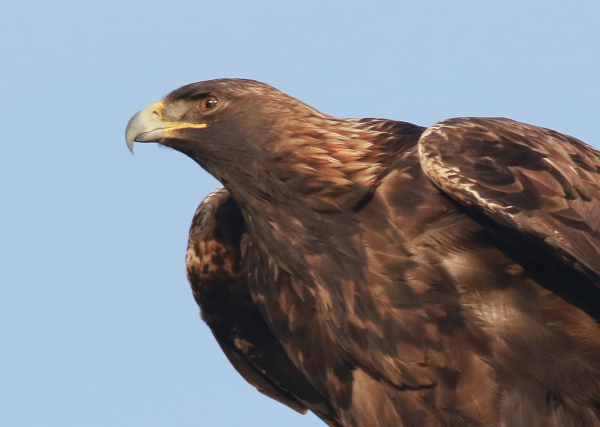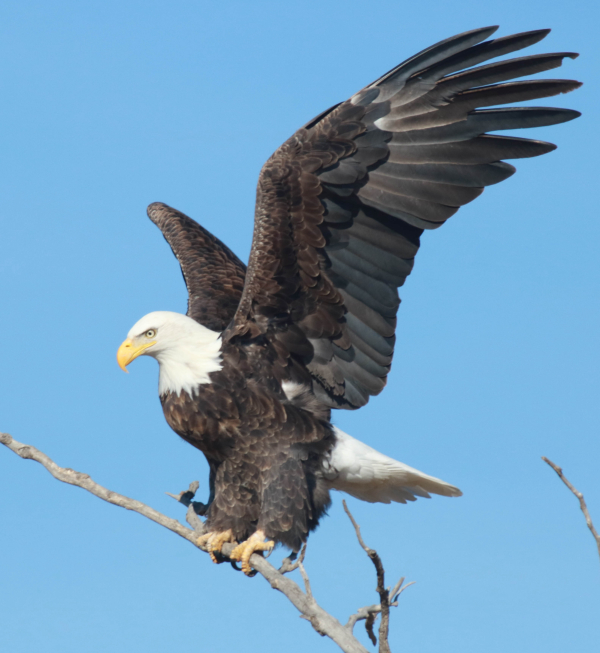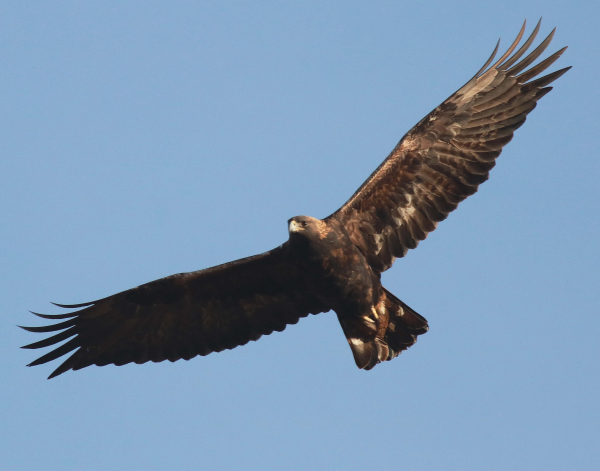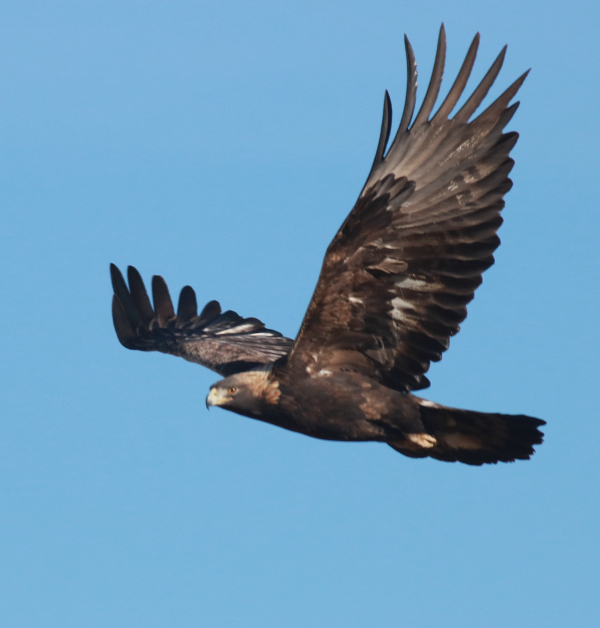Happy New Year! I’ve written about the importance of finding trusting birds to photograph – birds that permit us to approach and photograph them from a reasonable distance using a telephoto or zoom lens, without disturbing these special individuals. With time, we tend to feel a close association based on the birds’ acceptance of our proximity and good intentions, camera in hand. In the Bird Photography article in the December 16 issue, I wrote “I’m hoping to get some fine photographs before 2020 ends.”

Trusting eagles were the theme of the day, with this Golden Eagle providing a stunning image as it became alerted to the motion of potential prey. This close portrait was much improved by cropping the unsightly utility perch the eagle was using, and the crop also emphasized the focused attention of the eagle along with details of its face and plumage.
Luckily, I did get more photo opportunities through the trusting nature of not one, but 4 remarkable birds – a Snowy Owl, the return of the “chocolate” Rough-legged Hawk, and 2 eagles – a Bald Eagle and a Golden Eagle. Each one of these birds provided memorable, if not unbelievable, access to them as they hunted from perches. In addition, the most trusting Golden Eagle and 2 other Goldens provided flight foto opportunities, during which 2 of these grand eagles circled low overhead checking me out as I followed their flights through my camera viewfinder in the afternoon sunlight.
I included a couple photos of the Snowy Owl and chocolate-colored dark morph Rough-leg in this issue’s Editor Afield article with some background information, and herein I will provide insights into my photo experiences and techniques with the eagles. My eagle photo sessions took place during a most enjoyable day trip to my SoDak winter raptor hotspot, but more specifically across the open grasslands and ag fields south of Pierre, South Dakota.

The midday sunlight was a bit intense, bleaching out some of the white plumage of this grand Bald Eagle, but the lighting would get progressively better as the afternoon continued.
That day I identified and counted 60 birds of prey, including 6 Golden Eagles, 17 Bald Eagles, 18 Rough-legged Hawks, 17 Red-tailed Hawks, plus 2 American Kestrels. If you’re interested in statistics, in addition to photographing the 4 trusting eagles, I only had a chance to photograph 4 other raptors – 3 Rough-legged Hawks and another Golden Eagle. That’s 8 out of 60 raptors, only 1 out of every 7 or 8 raptors; but it’s a matter of working the stats to your advantage. Eventually, you will get your chances as long as you keep trying.
Wingspread Delight
My “eagle afternoon” began with a tree filled with eagles – 4 Bald Eagles that is, an adult and 3 immatures. I must admit that I was most interested in photographing the young eagles, but had no luck at all with them as they flew off unceremoniously. But the adult provided a happy ending from its low perch on the shore of the mighty Missouri River. I edged close, photographed, then edged a bit closer and settled in to take a nice series of portraits of the mostly inanimate eagle. Now let me explain a bit better that not only was I ‘edging closer,’ I was also trying to get into position where no extraneous or unsightly branches or background material were present in the photo frame.
As with other trusting birds, I spent some extra time with this noble symbol of America, hoping it would provide some level of action beyond turning its head from side to side. Suddenly, a pickup approached and I prepared for any action that might ensue – possibly with the eagle taking flight. In fact, the eagle did react, but instead of taking flight, it nervously raised its wings above its head in dramatic fashion, with me recording the movement with delight. The moment was exceptional. The eagle was hesitant to take flight, and after holding its wings upright a moment, it lowered them and folded them back into a normal perched position. However, the eagle kept its wings slightly apart from its body, which created a little more alert position that provided the best portrait photos.

What a thrill to see the Bald Eagle spread its wings overhead without taking flight – and to photograph the apex of its wingspread. The details of the wings, wing feathers, and other plumage is especially impressive in this image.
I certainly enjoyed this special photo opportunity, but even though I was in the right position for perfect light coverage, I knew the light was a bit on the harsh side. Indeed, if we want to be extra picky, some of the detail in the white feathers is a bit bleached out, as is the brown plumage to a lesser degree; but the strong light adds something too. It tends to highlight the outline of individual brown feathers, especially on the open wings.
Gosh, when I started photographing birds I never could have imagined getting such detail in my bird photos that individual feathers would be evident, even showing the details of single feathers, as well as the bird’s eyes, beak, and talons. It’s a personal thrill to see these photos, provided by such an impressive birds.
Golden Moments
Toward the end of the afternoon, in a remote southern corner of my SoDak raptor transect, I spied a big Golden Eagle perched on a wooden pole adjacent to a crossroads. The light was in my favor, mostly, and I cautiously approached the Golden and photographed it from a distance that should not have concerned it. Indeed, the eagle permitted me to photograph it, but with the sun a bit to the south of the bird and me a bit to the north, I was only getting prime light on the south half the eagle.
I really should have been on the south or southwest side of the eagle, rather than to the west of the eagle. Therefore, I wished to drive to the crossroads, gingerly turn the corner, and position myself in the best light possible south-southwest of the beautiful adult Golden Eagle. I didn’t want to disturb the bird, but eventually another vehicle would barrel down the same route without interest in the eagle or disturbing it, so I decided to give it a cautious try with the best of intentions and hope I wouldn’t flush the eagle. I literally crossed my fingers as I approached the corner and turned south – with the eagle in position mostly above me.
I couldn’t bear to look up as I eased past the Golden, and only dared to breathe again as I steered my mobile blind wide into place on the roadside in just the right position. I held my breath again as I raised my camera into position, bracing it against the open window frame, and began taking some stunning close portraits of this regal bird of prey. Golden Eagles always give me a special level of excitement, and as with the Bald Eagle, I had ample opportunities to take all the photos I wanted in the lightly fading sunlight. Yet I waited for a little action that might provide the special image I hoped for.

This Golden Eagle showed its ultra-broad wingspan as it circled low overhead, and even though the sun only illuminated half the bird, it is an image Paul wanted to share to show a different lighting option, and to illustrate the full majesty of a Golden Eagle in soaring flight.
It didn’t take much; the eagle merely lowered its head and leaned forward with its wings at ready in supposed response to seeing potential prey. That’s when I took the ultimate Golden portrait that revealed extreme detail in the eye of the bird, as well as other features. Shazam! Wowie-zowie! In another moment, the Golden Eagle took flight, and I followed its progress taking photos, even though I was a bit behind the eagle’s forward motion and outside the realm of the best light.
The obliging eagle repositioned in a tree a quarter-mile away, but first I needed to review how that ultimate portrait photo looked through my camera’s LCD monitor. There was one image that caught the best “pose,” and I enlarged the image a bit within the monitor to get an idea of what it would look like when I cropped out extraneous portions of the photo. After all, it was perched atop an unsightly power pole with all the wire and insulators and bolts that don’t exactly add to the eagle ambiance I envisioned in this photograph.
Low-Soaring Goldens
My birding episode with this trusting Golden Eagle took me back down the road, where I actually drove beneath it and past it, returning with the sun at my back. I stopped on the all but abandoned dirt road and got out to stretch a bit while keeping tabs on the perched eagle. I walked a short distance away from the Golden’s position, only to see it take flight in potentially good light. In fact, the eagle winged in a low circle that passed directly over my head before returning to its perch. Gosh, that was an unusual flight I thought, imagining that the eagle was actually checking on my activity outside my usual mobile blind. Nonetheless, I took a series of photos of the eagle in flight to add to my images of it perched, then left aquila to continue its hunt as the sun dipped lower in the afternoon sky.

Few birds attract such attention as eagles – for birders and the general public alike. Their size and wariness make seeing Bald and Golden Eagles at close quarters memorable, and the opportunity to observe and photograph both species on the same day made this field trip especially rewarding.
|
About a mile and a half to the west, I sighted another Golden Eagle perched in a tree, but as I approached, the big raptor took flight into potentially good light. I was surprised that it flew south, parallel to my position, and I hopped out of my vehicle to get a better view of the bird’s progress. While this eagle didn’t initially show the same trust as the previous one, it did show a degree of interest as it turned in my direction and circled relatively low above me too – what luck! During my favorite photo moment of this surprise encounter, the eagle showed its ultra-broad wingspan as it circled, and even though the sun only fully illuminated half the bird, it is an image I wanted to share with you here for a little different lighting option, and to show the full majesty of a Golden Eagle in soaring flight.
One more Golden Eagle obliged me with a photo opportunity that afternoon: This beautiful female was perched near a prairie dog town, and I breathed a sigh of relief as a rare ranch truck ambled ahead of me without alarming the eagle.
Tech Info
Throughout this article I have sprinkled many techniques and tips within my eagle photo episodes, but permit me to provide my technical information in a little more direct form here. As usual, I used my trusty 400mm telephoto lens to photograph the eagles, both to magnify the size of the birds in the resulting digital images, and so I could keep an appropriate distance from the birds so I did not alarm them or alter their behaviors.
In the sunshine I used an ISO of 400, with the Aperture Priority – Av – setting on my camera’s Dial Mode, allowing me to choose my aperture (f-stop) while the camera automatically sets the corresponding shutter speed, depending on the amount of ambient light. For most photos, I want to use the fastest possible shutter speed while still keeping the bird in focus; so by using an f-stop of f7, the eagles were clearly in focus, while the Av priority setting automatically provided a fast shutter speed. That shutter speed varied from 1/2500 during midday to 1/800 as the sunlight was beginning to fade about an hour before sunset – still plenty of speed to stop the motion of a circling Golden Eagle.
Even with the sun’s position at its lowest point in the first of winter sky, the quality of the sunlight was very bright during midday, almost too bright. About 3:00pm the sun may have been at its best, but by 4:00 the light had yellow tinge, which can be detected on the photo of the soaring eagle, and to a little lesser extent on the first portrait of the Golden Eagle. Certainly, during spring and summer days, during midday the sun is especially harsh and the angle of the sun is almost directly overhead. But now, during the shortest days of the year I thought I was safe photographing during midday, but perhaps the fact that I was very close to midday eagles was a contributing factor too. Nonetheless, I have reacted by trying to photograph before or after midday, even during this winter period of the year.
Uno Mas Aquila
One more eagle, another Golden Eagle obliged me with a photo opportunity that afternoon: The beautiful female was perched near a favorite remote road, and I breathed a sigh of relief as a ranch truck ambled ahead of me without alarming the big raptor. I slowly continued my approach, but as I began to ease toward a stop the eagle took flight. Even so, that worked to my advantage as she flew toward me into the sunlight, providing a quick series of photos as she passed my position after I stopped and turned off the engine.
This eagle continued to the west, flying above the midst of the vast rolling prairie that’s part of the Fort Pierre National Grasslands, along a road where Golden Eagles, Rough-legged Hawks, Prairie Falcons, and on the rarest of winter occasions a Gyrfalcon might alight. If there is one thing that’s true about photographing birds it’s that under the best conditions, we still must react to on the actions of the birds we hope to make the honored subjects of our photographs. And that’s what makes bird photography interesting and exciting, during successes and misses; and during remarkable days when 4 eagles representing both American species provided memorable images that will rank among my favorites – now that’s quite a successful day of birding!
Article and photographs by Paul Konrad
Share your bird photos and birding experiences at editorstbw2@gmail.com